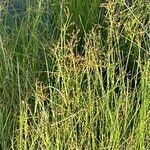Herbs, perennial, cespitose, 2--7 dm. Culms erect, 1--4 mm diam., smooth. Cataphylls 1--2, straw-colored to pink, apex acute. Leaves: basal 1--3, cauline 1--2; auricles 0.6--1.5 mm, apex rounded, scarious; blade terete to compressed, 0.2--12 cm ?x 0.5--2 mm. Inflorescences panicles of 5--80 heads, 5--25 cm, branches ascending; primary bract erect; heads 2--6-flowered, ellipsoid to obovoid, 2--5 mm diam. Flowers: tepals green to light brown, lanceolate; outer tepals 1.8--2.5 mm, apex obtuse to nearly acute; inner tepals 2--2.8 mm, apex obtuse to nearly acute; stamens 3 or 6, anthers 1/2 filament length. Capsules exserted, chestnut to dark brown, imperfectly 3-locular, obconic, 2.4--3.8 mm, apex acute proximal to beak, valves separating at dehiscence. . Seeds ellipsoid to fusiform, 0.8--1.2 mm, tailed; body covered with whitish translucent veil. 2n = 80.


